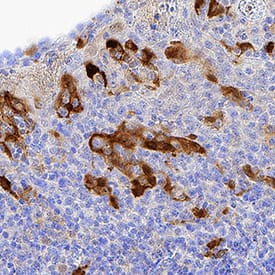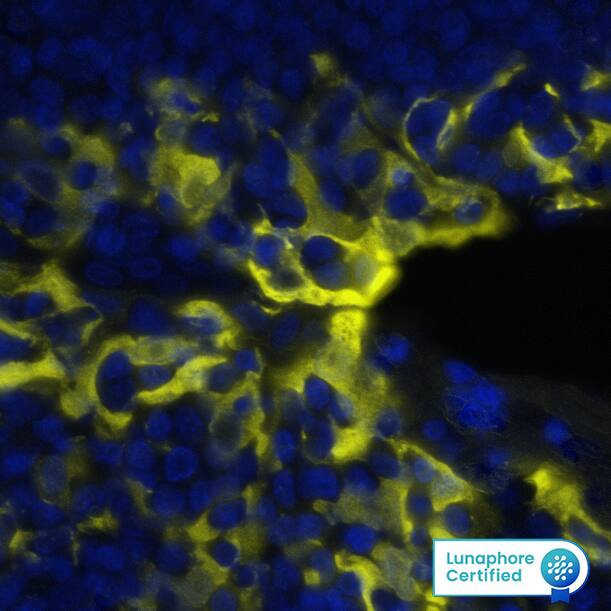Human Indoleamine 2,3-dioxygenase/IDO Antibody
R&D Systems, part of Bio-Techne | Catalog # MAB60301

Key Product Details
Species Reactivity
Validated:
Human
Cited:
Human
Applications
Validated:
Immunohistochemistry, Multiplex Immunofluorescence
Cited:
Immunohistochemistry
Label
Unconjugated
Antibody Source
Monoclonal Mouse IgG1 Clone # 998743
Product Specifications
Immunogen
E. coli-derived recombinant human Indoleamine 2,3‑dioxygenase/IDO
Ala2-Gly403
Accession # P14902
Ala2-Gly403
Accession # P14902
Specificity
Detects human Indoleamine 2,3‑dioxygenase/IDO in direct ELISAs.
Clonality
Monoclonal
Host
Mouse
Isotype
IgG1
Scientific Data Images for Human Indoleamine 2,3-dioxygenase/IDO Antibody
Detection of IDO1 in Human Tonsil via seqIF™ staining on COMET™
IDO1 was detected in immersion fixed paraffin-embedded sections of human Tonsil using Mouse Anti-Human IDO1, Monoclonal Antibody (Catalog # MAB60301) at 1ug/mL at 37 ° Celsius for 4 minutes. Before incubation with the primary antibody, tissue underwent an all-in-one dewaxing and antigen retrieval preprocessing using PreTreatment Module (PT Module) and Dewax and HIER Buffer H (pH 9; Epredia Catalog # TA-999-DHBH). Tissue was stained using the Alexa Fluor™ 555 Goat anti-Mouse IgG Secondary Antibody at 1:100 at 37 ° Celsius for 2 minutes. (Yellow; Lunaphore Catalog # DR555MS) and counterstained with DAPI (blue; Lunaphore Catalog # DR100). Specific staining was localized to the cytoplasm. Protocol available in COMET™ Panel Builder.Indoleamine 2,3‑dioxygenase/IDO in Human Tonsil.
Indoleamine 2,3-dioxygenase/IDO was detected in immersion fixed paraffin-embedded sections of human tonsil using Mouse Anti-Human Indoleamine 2,3-dioxygenase/IDO Monoclonal Antibody (Catalog # MAB60301) at 1.7 µg/mL for 1 hour at room temperature followed by incubation with the Anti-Rabbit IgG VisUCyte™ HRP Polymer Antibody (Catalog # VC003). Before incubation with the primary antibody, tissue was subjected to heat-induced epitope retrieval using Antigen Retrieval Reagent-Basic (Catalog # CTS013). Tissue was stained using DAB (brown) and counterstained with hematoxylin (blue). Specific staining was localized to lymphocytes. View our protocol for IHC Staining with VisUCyte HRP Polymer Detection Reagents.Applications for Human Indoleamine 2,3-dioxygenase/IDO Antibody
Application
Recommended Usage
Immunohistochemistry
1-25 µg/mL
Sample: Immersion fixed paraffin-embedded sections of human tonsil
Sample: Immersion fixed paraffin-embedded sections of human tonsil
Multiplex Immunofluorescence
1 µg/mL
Sample: Immersion fixed paraffin-embedded sections of human Tonsil tissue
Sample: Immersion fixed paraffin-embedded sections of human Tonsil tissue
Formulation, Preparation, and Storage
Purification
Protein A or G purified from hybridoma culture supernatant
Reconstitution
Reconstitute at 0.5 mg/mL in sterile PBS. For liquid material, refer to CoA for concentration.
Formulation
Lyophilized from a 0.2 μm filtered solution in PBS with Trehalose. See Certificate of Analysis for details.
*Small pack size (-SP) is supplied either lyophilized or as a 0.2 µm filtered solution in PBS.
*Small pack size (-SP) is supplied either lyophilized or as a 0.2 µm filtered solution in PBS.
Shipping
Lyophilized product is shipped at ambient temperature. Liquid small pack size (-SP) is shipped with polar packs. Upon receipt, store immediately at the temperature recommended below.
Stability & Storage
Use a manual defrost freezer and avoid repeated freeze-thaw cycles.
- 12 months from date of receipt, -20 to -70 °C as supplied.
- 1 month, 2 to 8 °C under sterile conditions after reconstitution.
- 6 months, -20 to -70 °C under sterile conditions after reconstitution.
Background: Indoleamine 2,3-dioxygenase/IDO
References
- Lewis-Ballester, A. et al. (2009) Proc. Natl. Acad. Sci. USA. 106:17371.
- Costantino, G. (2009) Expert Opin. Ther. Targets 13:247.
- Xu, H. et al. (2008) Immunol. Lett. 121:1.
- Lob, S. et al. (2009) Nat. Rev. Cancer 9:445.
- Curti, A. et al. (2009) Blood 113:2394.
Alternate Names
3dioxygenase, IDO, IDO1, INDO, Indoleamine 2
Gene Symbol
IDO1
UniProt
Additional Indoleamine 2,3-dioxygenase/IDO Products
Product Documents for Human Indoleamine 2,3-dioxygenase/IDO Antibody
Product Specific Notices for Human Indoleamine 2,3-dioxygenase/IDO Antibody
For research use only
